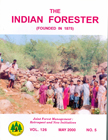Participatory Approach in Indian Forestry in Mstorical Perspective
DOI:
https://doi.org/10.36808/if/2000/v126i5/3190Abstract
Joint Forest Management is not an entirely new concept in Indian Forestry because rudiments of this approach can be traced backwards to 'Sacred Groves', 'Kans' and 'Orans' etc. Mauryan rulers kept -special forests for public use. This continued well through Mughal times till the advent of the British administration. Brandis, the founder of state-managed forestry in India had deep regard for traditional institutions and tried for more than a decade for the establishment of village forests on degenerated and wastelands, which were also to provide for grazing. Such a scheme was launched in Mysore State. A provision for village forests is also included in the Indian Forest Act, 1929. The Royal Commission on Agriculture also suggested utilization of cultivable wastelands, and other degenerated lands for making Village Forests, to be managed by Panchayats. All this has been imbibed by the present Joint Forest Management approach to Indian Forestry.Downloads
Download data is not yet available.
Downloads
Published
2000-05-01
How to Cite
Rawat, J. K., & , R. (2000). Participatory Approach in Indian Forestry in Mstorical Perspective. Indian Forester, 126(5), 449–452. https://doi.org/10.36808/if/2000/v126i5/3190
Issue
Section
Articles
License
Unless otherwise stated, copyright or similar rights in all materials presented on the site, including graphical images, are owned by Indian Forester.





